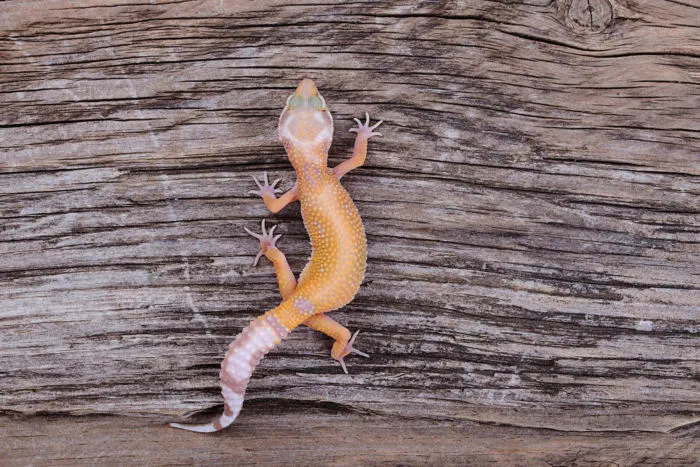 Watch any gecko go about his business, and you will undoubtedly see that these creatures are great at climbing. It is unreal to see it in person: A tiny creature scaling the wall like nature’s very own secret agent. The way they defy gravity is utterly fantastic.
Watch any gecko go about his business, and you will undoubtedly see that these creatures are great at climbing. It is unreal to see it in person: A tiny creature scaling the wall like nature’s very own secret agent. The way they defy gravity is utterly fantastic.
How can we give them the chance to climb in their habitats?
Can leopard geckos climb? Leopard gecko toes do not feature a sticky property that helps them stick to and scale walls. Most geckos have this amazing gift, and it helps them escape and stay away from predators. However, leopard geckos have claws instead of toe pads. Nonetheless, they are pretty good climbers.
Now you know what gives these geckos their excellent climbing ability. To learn more about the science behind it, and ways you can promote this behavior in your leo, keep on reading.
Let’s Talk About Gecko Feet
Geckos can stick to various surfaces thanks to their bulbous toes. These toes are covered in setae or microscopic hairs. These setae break off into smaller bristles called spatulae. These spatulae contour to the walls and ceilings using what is known as the van der Waals force.
To simplify this complex concept, these are relatively weak electric forces that work to attract molecules of a neutral nature to one another when it comes to solidified and liquefied gases, and also in organic liquids and solids, says Encyclopedia Britannica.
Mainly, the electrons in the hair molecules of the gecko and the molecules of the wall join forces to form an electromagnetic attraction, enabling your reptile buddy to stick to the wall like magic.
Researchers have also figured out how they can crawl so quickly, too. Geckos can bond and unbond their feet so fast that they can run 20 body lengths up a wall with no trouble whatsoever.
Says one professor at Oregon State University, Alex Greaney, it is the synergy of the hairs’ flexibility, angle, and extensibility that allows them to do this.
Understanding This Phenomenon with Math
Using the power of math, Greaney and his team were able to create a model that tells how the forces and the angle of the setae work as a gecko climbs up the walls. The result is a powerful but very delicate system of adhesion.
The setae do not stand at a perfect 90-degree angle. They instead sprout at oblique angles.
The model states that if the hairs curve at an angle that is more horizontally inclined, the surface area that the geckos can adhere to gets larger, and the geckos can support greater amounts of weight.
These setae are also brilliantly engineered-they are super flexible. When you see a gecko hop from one surface or change his direction as a means of avoiding a predator, the toe hairs have to be able to absorb and redirect vast amounts of energy.
The stretchy nature and ultra-flexibility of the setae aid in this redirection and make it easy for the gecko to move across surfaces regardless of angle.
There is one caveat, however: If the surface is covered in excess moisture, the stickiness of their feet is diminished, and their feet begin to slip.
The same model also proved that geckos are capable of balancing out gravity’s forces by using their own force on a wall. They are able to press and slide their feet in the direction of their body and move their feet across various surfaces without falling off.
So Why Not Leopard Geckos?
Leopard geckos are known as “terrestrial” reptiles. It means they tend to stick close to the ground. They do not like to climb as high as some other species of geckos do.
After all, many geckos do it as a way to escape from predators, and we have learned that the leopard gecko has a different way of escaping: That is, they drop their tails as a means of escaping.
Even though these reptiles do not climb as much as others, it’s still important to keep the habitat conducive to keeping your gecko safe.
Make sure your
You will also want to make sure that your gecko cannot easily climb out of the
Wire mesh cages are a weak choice as they risk getting their feet stuck. Also, you have to worry about the heat escaping from the cage, and these are also pretty easy for geckos to get out of.
Lids also matter in making sure your leopard gecko does not climb out. The lid keeps things that could stress out your gecko-such as kids, pets or harmful insects-out of the
Opt for a screen cover that will keep air circulating and avoid solid lids. It will help maintain temperature and humidity at safe levels.
What Can I Put in The Tank for My Leo to Climb?
Leos do like to climb to an extent. You can add in rocks, sticks, small logs, and other objects (we like replica dinosaur skulls in ours) to give your leo a place to climb, perch, play, and bask. You can pick up rocks and logs from outdoors, but they have to be sanitized first.
This process is not complicated, but you must be thorough in how you approach it. For instance, smooth out a pointy rock, so your reptile does not injure himself. Clean the rocks thoroughly, so all dirt and bacteria are removed.
Get rid of all bark on sticks and verify that parasites do not live on the wood. You may also bake it in the oven after surface cleaning to kill off any remaining parasites. You bake them for about 20-30 minutes.
To sanitize your gecko’s rocks and other
Use a solution of 90% water and 10% bleach OR a good reptile safe spray to sanitize them. Allow the spray or bleach solution to sit on the object for 30 minutes.
Then, rinse them off thoroughly and verify that no fumes are present on the
Could There Be Other Reasons My Gecko Is Climbing?
We already learned that geckos of all types climb because they are looking to get away from predators.
Geckos new to their environments will test it out, regardless of their type. For instance, even though leopard geckos are not known for being the strongest climbers, they may try to climb up the glass.
It is normal behavior, and your gecko should stop doing it once they get used to their new home.
However, if you find that this does not stop, you should evaluate the habitat to make sure it is comfortable for your gecko. It could be an indication that something inside the habitat is not conducive to your gecko’s well-being.
While it is not a good idea to keep more than one gecko in a habitat, the climbing of your leopard gecko could be the result of trying to get away from a
A gecko of the opposite gender may be attempting to mate with your gecko, and the climbing may be an attempt to get away from these advances.
So, What Can I Do?
If you find that a
You should also check
Fun with Climbing
Let your leo get used to your hand by having him climb onto it. Sit on the floor and allow your Leo to use his claws to climb on your shoulder and arm. Make sure you watch him closely, so he does not fall.
It helps you bond with your leo; he gets to burn off energy by climbing on an easy to grip surface.
Conclusion
Leos are great climbers, provided they have the right conditions. Let your Leo get his fill by providing playtime, clean
- Enchi Ball Python: A Unique and Stunning Morph of Python regius - March 27, 2025
- Emerald Tree Monitor: The Enigmatic Green Guardian of the Rainforest - March 26, 2025
- The Egyptian Cobra (Naja haje): A Fascinating Serpent - March 25, 2025
